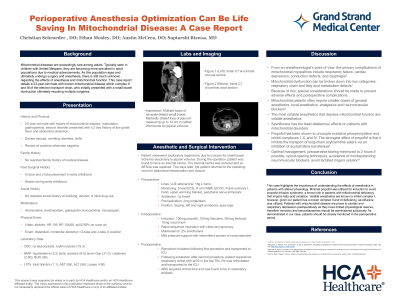Back

Other
Category: Quickshot Oral Session 10
Quickshot Oral : Quickshot Oral Session 10
PERIOPERATIVE ANESTHESIA OPTIMIZATION CAN BE LIFE SAVING IN MITOCHONDRIAL DISEASE: A RARE CASE REPORT
Sunday, February 12, 2023
7:00am – 8:00am East Coast USA Time


Christian Schroeder, DO
resident
Grand Strand Medical Center, United States- AM
Austin McCrae, DO
United States
Presenter(s)
Principal Contact(s)
Objectives: Mitochondrial diseases are exceedingly rare among adults. Typically seen in children with limited lifespans, they are becoming more prevalent in adult populations due to medical advancements. As this population ages and ultimately undergo surgery and anesthesia, there is still much unknown regarding the effects of anesthesia and mitochondrial function. This case report details a 23-year-old male with known mitochondrial disease within complex II and III of the electron transport chain, who initially presented with a small bowel obstruction ultimately requiring multiple surgeries.
Methods: In addition to his mitochondrial deficiency, the patient has a complicated medical history including seizure disorder, gastroparesis, and physical and mental developmental delay. He had multiple childhood abdominal surgeries culminating in G-tube and J-tube placement for gastroparesis and enteral nutrition, respectively. Patient initially presented with abdominal pain and found to have a small bowel obstruction secondary to sigmoid volvulus. There was concern for bowel ischemia, leading to exploratory laparotomy. Patient was optimized preoperatively with placement of arterial line, ABG and hemodynamic monitoring. Patient was premedicated with midazolam. Depolarizing muscle relaxants were avoided and the patient was induced with propofol, rocuronium, and lidocaine. RSI with video laryngoscope was utilized due to anticipated airway difficulties. Phenylephrine was utilized after induction to maintain adequate blood pressure, but remained hemodynamically stable throughout. Anesthesia was maintained with sevoflurane. Patient remained intubated following and was admitted to the ICU. He was not extubated for further optimization, tenuous perioperative status, and anticipation of further intervention. During his second procedure, fentanyl was administered at induction; naloxone and sugammadex were required to facilitate extubation. In route to ICU, the patient was cyanotic with SpO2 readings in the low 70’s, and required re-intubation. The patient’s respiratory arrest was thought to be due to respiratory acidosis discovered incidentally on blood gas.
Results: This case highlights the importance of understanding the effects of anesthetics in patients with altered physiology. Minimal propofol was utilized for induction to avoid propofol-infusion syndrome, a known risk in patients with mitochondrial deficiency that impairs fatty-acid oxidation. Volatile anesthetics are known to inhibit complex I; however, given our patient has a known complex II and III deficiency, sevoflurane was utilized. Patients with mitochondrial disease are prone to cardiac and respiratory depression postoperatively as they have limited physiological reserve, therefore narcotics and benzodiazepines should be administered judiciously.
Conclusion: As demonstrated in our case, patients should be closely monitored in the perioperative period.
Methods: In addition to his mitochondrial deficiency, the patient has a complicated medical history including seizure disorder, gastroparesis, and physical and mental developmental delay. He had multiple childhood abdominal surgeries culminating in G-tube and J-tube placement for gastroparesis and enteral nutrition, respectively. Patient initially presented with abdominal pain and found to have a small bowel obstruction secondary to sigmoid volvulus. There was concern for bowel ischemia, leading to exploratory laparotomy. Patient was optimized preoperatively with placement of arterial line, ABG and hemodynamic monitoring. Patient was premedicated with midazolam. Depolarizing muscle relaxants were avoided and the patient was induced with propofol, rocuronium, and lidocaine. RSI with video laryngoscope was utilized due to anticipated airway difficulties. Phenylephrine was utilized after induction to maintain adequate blood pressure, but remained hemodynamically stable throughout. Anesthesia was maintained with sevoflurane. Patient remained intubated following and was admitted to the ICU. He was not extubated for further optimization, tenuous perioperative status, and anticipation of further intervention. During his second procedure, fentanyl was administered at induction; naloxone and sugammadex were required to facilitate extubation. In route to ICU, the patient was cyanotic with SpO2 readings in the low 70’s, and required re-intubation. The patient’s respiratory arrest was thought to be due to respiratory acidosis discovered incidentally on blood gas.
Results: This case highlights the importance of understanding the effects of anesthetics in patients with altered physiology. Minimal propofol was utilized for induction to avoid propofol-infusion syndrome, a known risk in patients with mitochondrial deficiency that impairs fatty-acid oxidation. Volatile anesthetics are known to inhibit complex I; however, given our patient has a known complex II and III deficiency, sevoflurane was utilized. Patients with mitochondrial disease are prone to cardiac and respiratory depression postoperatively as they have limited physiological reserve, therefore narcotics and benzodiazepines should be administered judiciously.
Conclusion: As demonstrated in our case, patients should be closely monitored in the perioperative period.

